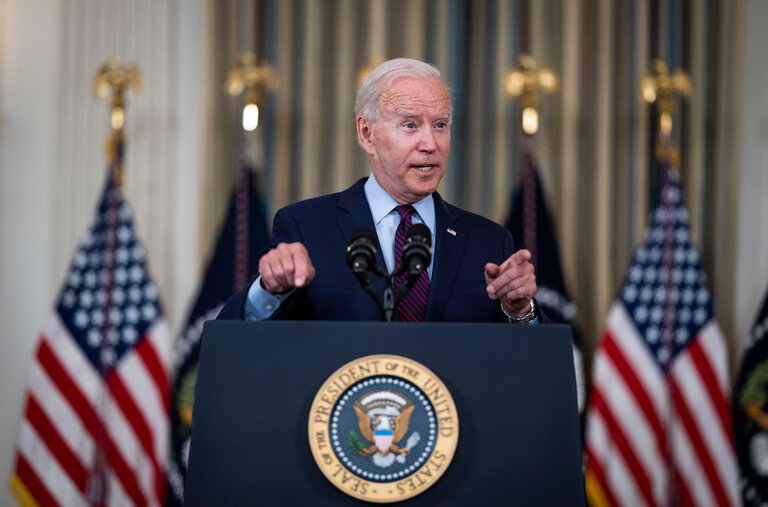After signing his historic $1.9 trillion COVID-19 relief bill into law in March 2021, President Joe Biden is moving on to the next chapter of his tenure — infrastructure and social programs.
Infrastructure is the basic systems — roads, buildings, power grids, etc. —that are crucial for supporting the operation of both society and the economy. According to the American Society of Civil Engineers (ASCE), U.S. infrastructure averages a “C-” rating, the highest grade in two decades. Experts argue an overhaul is essential to prevent falling behind economic competitors such as China, warning failure to do so will be of significant cost.
Biden’s massive “Build Back Better” infrastructure plan encompasses arguably everything he campaigned on: creating jobs, lowering taxes for working families, expanding Medicare, accessible child care and education reform. The plan also tackles climate change, striving to reduce carbon emissions and lower energy costs.
Biden described the investments as “long overdue,” seeking to work on a bipartisan basis to ensure passage of the spending bill. However, the reluctance of both Republicans and centrist Democrats has turned this ambitious endeavor into a difficult feat. Here’s VALLEY’s breakdown of the facts.
The Bill
The $3.5 trillion spending plan has become a social-spending policy of sorts through reconciliation — a way for Congress to pass legislation on spending, taxes or the federal debt limit with a majority. This avoids a filibuster that requires 60 votes to overcome.
President Biden’s 10-year plan combines a multitude of initiatives. It includes universal preschool, funding for two years of community college regardless of family income, expansion of child care and a long-awaited path to citizenship for upwards of eleven million undocumented immigrants.
As for healthcare, the Biden administration intends on expanding Medicare to include dental, vision and hearing services. It also aims to lower prescription drug prices by allowing Medicare to negotiate for the best deal, something currently prohibited by law. Additionally, the plan offers 12 weeks of family and medical leave.
Moreover, the Clean Electricity Performance Program is one of several provisions incorporated within the plan to combat climate change, designed to achieve a net-zero economy by 2050. Promotion of renewable energy is of top priority too, incentivized by imposing financial penalties for utility companies that do not increase their renewable energy output by four percent every year. Furthermore, substantial funding will go towards forest conservation and wildfire management services, among other things.
The plan will be funded, in large part, by raising taxes on corporations (from 21 to 28%) and the wealthy (39.6% for households making over $453,000.)
The Challenges
Considering there is a 50-50 Senate, Democrats need unanimity for legislation to go anywhere. However, two key swing votes, Sen. Joe Manchin, D-W.Va., and Sen. Kyrsten Sinema, D-Ariz., have made it abundantly clear they refuse to endorse Biden’s plan unless compromises are met.

Manchin, who also stalled Democrats’ 2021 Coronavirus stimulus bill, wants to shrink the $3.5 trillion spending plan to $1.5 trillion. He opposes the climate provisions, the extension of the child tax credit and expansion of Medicare. In a brief interview with National Review on Sept. 29, Manchin said the reconciliation bill is “dead on arrival” if it does not include the Hyde Amendment — a controversial legislative provision prohibiting federal funding of abortion.

Likewise, Sinema wants to cut down the price tag. Other than opposing the proposed re-write of the tax code and drug pricing, Sinema has been somewhat quiet on what she wants to change — her silence being much to the dismay of her congressional colleagues as deadlines approach. Protesters have urged her to keep her campaign promise and vote yes, instead, she embarked on a fundraising trip to Europe.
Despite these obstacles, a Vox and Data for Progress poll expressed that 63% of voters support the “Build Back Better” plan “that includes spending on health care, long-term care, child care, and clean-energy jobs.” In that same poll, an overwhelming 71% expressed support for raising taxes on the top 2% of Americans to fund the spending plan — sending a clear message to their representatives.
What do you think about President Biden’s “Build Back Better” plan? Let us know by tweeting us, @VALLEYmag, on Twitter!






I’d need to check with you here. Which is not one thing I often do! I take pleasure in studying a put up that can make people think. Also, thanks for permitting me to comment!